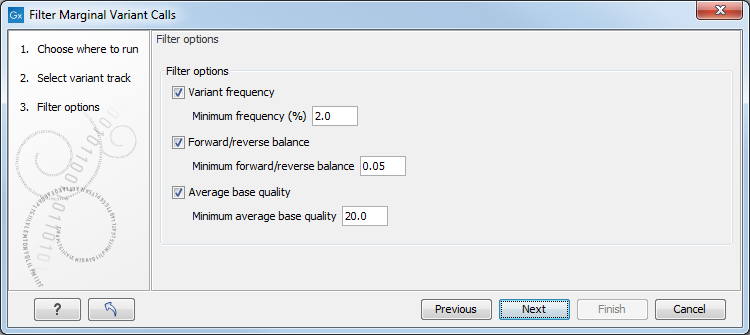Remove Marginal Variants
Variant calling is always a balance between sensitivity and specificity. To get rid of potential false positive variants, you can use this tool on a variant track to remove some of the variant calls, which are supported by only low quality bases, have low frequency or a skewed forward-reverse reads balance. In this way, you can try different strategies for filtering without re-running the variant detection.
Toolbox | Resequencing Analysis (![]() ) | Variant Filtering (
) | Variant Filtering (![]() ) | Remove Marginal Variants (
) | Remove Marginal Variants (![]() )
)
This opens a dialog where you can select a variant track (![]() ) with experimental data that should be filtered.
) with experimental data that should be filtered.
Click Next to set the filtering thresholds as shown in figure 29.2

Figure 29.2: Specifying thresholds for filtering.
The following thresholds can be specified. All alleles except the reference allele are investigated separately, but in order to remove a variant, all non-reference alleles have to fulfill the requirements.
- Variant frequency. The frequency filter will remove all variants having alleles with a frequency (= number of reads supporting the allele/number of all reads) lower than the given threshold.
- Forward/reverse balance. The forward/reverse balance filter will remove all variants having alleles with a forward/reverse balance of less than the given threshold.
- Average base quality. The average base quality filter will remove all variants having alleles with an average base quality of less than the given threshold.
If several thresholds are applied, just one needs to be fulfilled to discard the allele. For more information about how these values are calculated, please refer to Variant tracks.
The result is a new track where all variants (or at least one non-reference allele of the variant) fulfill the criteria.
